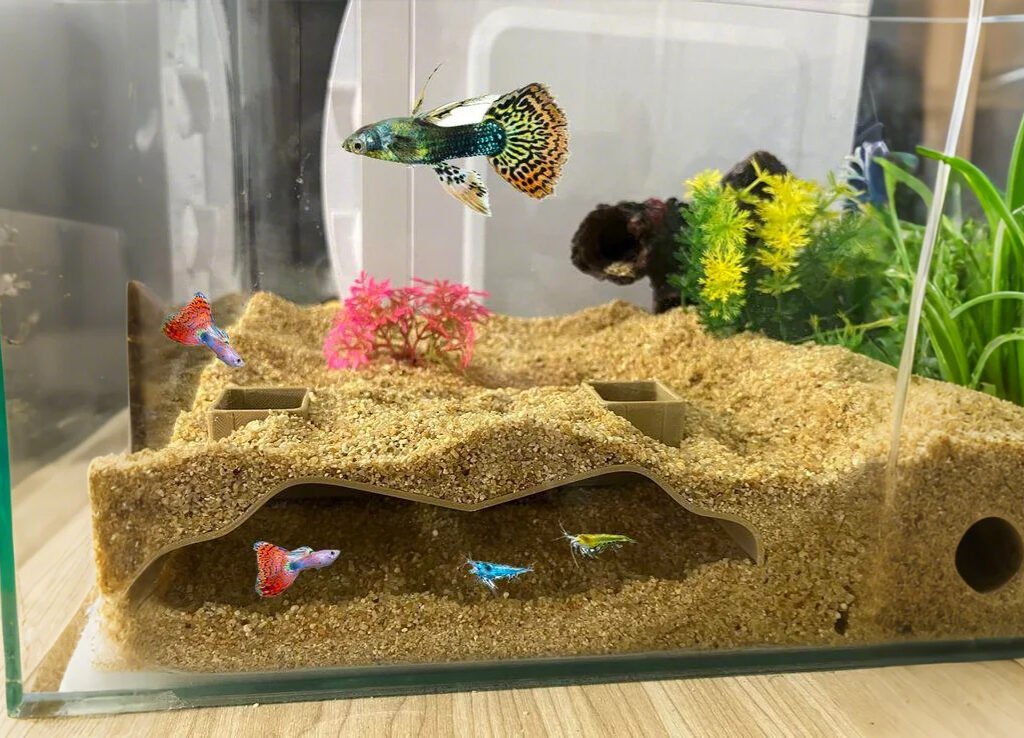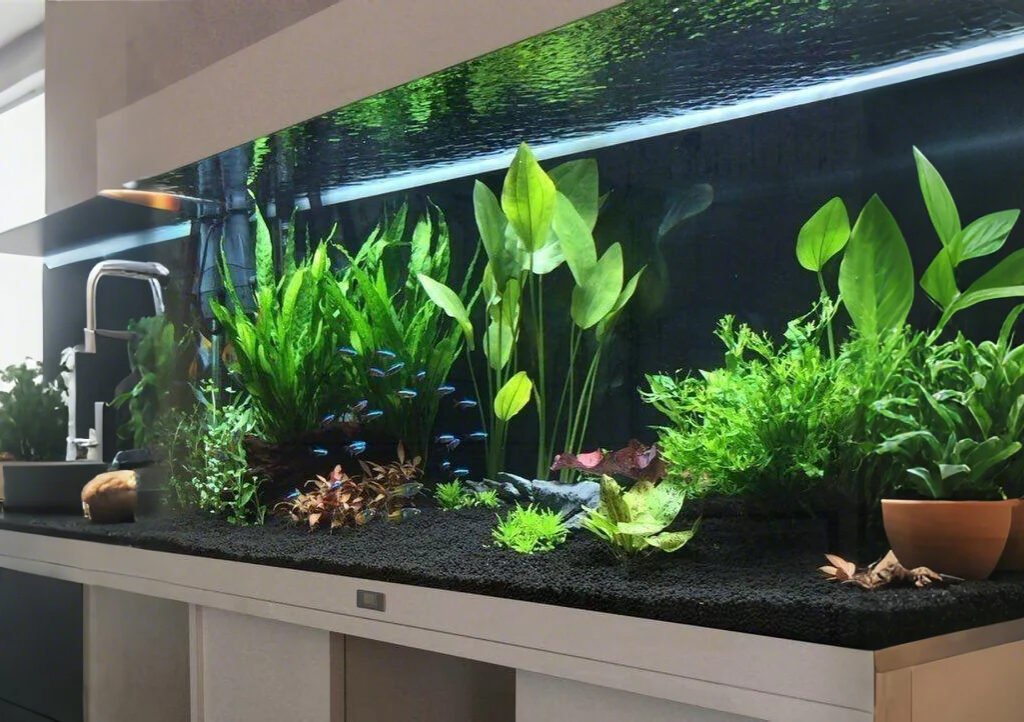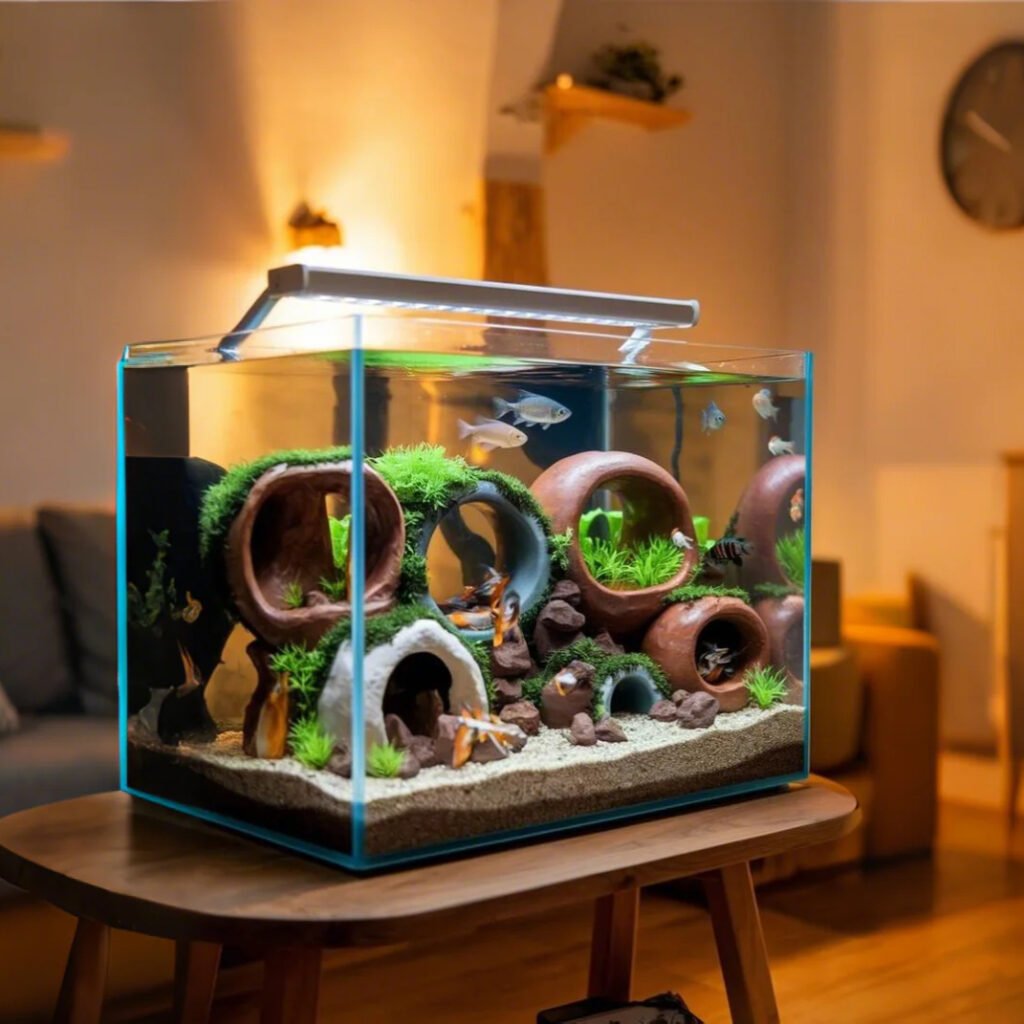Top 10 common Aquarium Mistakes Beginners Make
Thank you for being here! Today, we’ll talk about the top 10 common aquarium mistakes beginners make. If you are starting out or want to do better, this guide will help you avoid problems. These tips can save your time, money, and fish.
I’ve been keeping fish for over 45 years and hold advanced degrees in biotechnology and aquaculture. I’m here to help you thrive in this amazing hobby. Plus, I’d love for seasoned aquarists to jump into the comments and share their own insights with the community!
Now, you’ll learn the Top 10 Mistakes New Fish Keepers Make, practical tips to avoid them, and essential habits that will set you up for long-term success.

1. Putting the Tank in the Wrong Spot
Setting up your fish tank is fun. But putting it in the wrong place can cause problems later. Many new fish keepers put their tank where it looks nice or is easy to reach. But that place might not be good for your fish.
Let’s look at the best places—and worst ones—for your tank.
Don’t Put It in the Sun
A sunny window might seem like a great spot. But sunlight makes algae grow fast. It can turn your clean tank green. It also heats the water too much, which can stress your fish.
Why it matters: Fish need stable water. Too much light and heat are bad for them.
Stay Away from Drafts and Noise
Don’t place your tank near doors, windows, or vents. These places can cause sudden hot or cold air. That can hurt your fish. Also, avoid loud spots like the kitchen or hallway. Noise and movement can scare your fish and make them sick.
Why it matters: Fish need quiet and steady temperatures to stay healthy.
Pick a Calm, Safe Place
Choose a quiet room like a bedroom or office. Make sure the tank is on a strong, flat stand. It should be near outlets for your filter, heater, and lights. Leave space to clean and do water changes.
Why it matters: You’ll see your fish often and take better care of them.
Avoid basements or back rooms. You want to see your tank every day. It’s easier to spot problems early.

2. Skipping the Nitrogen Cycle
The nitrogen cycle is key to keeping your fish alive. Many beginners skip it—and that’s why fish die.
Let’s make it simple.
Fish Waste = Poison
Fish make waste. Leftover food, poop, and dead plants turn into ammonia. Ammonia is poison. Even a little can kill fish.
The water may look clean, but the danger is still there.
Good Bacteria Help
Good bacteria grow in your filter and on your gravel and decorations.
Here’s what they do:
Step 1: First, one kind of bacteria changes ammonia to nitrite.
Bad news: Nitrite also harms fish.
Step 2: Another kind of bacteria turns nitrite into nitrate.
Better news: Nitrate is safer—but not too much!
How to Control Nitrate
- Do weekly water changes (about 25%).
- Add live plants. They help absorb nitrate.
- Don’t feed too much. Extra food makes more waste.
Wait Before Adding Fish
Let bacteria grow first. This is called cycling.
Two ways to do it:
- Fishless: Add a bit of ammonia or food.
- With fish: Use hardy fish. Change water often.
Test your water often. You are ready when:
- Ammonia = 0
- Nitrite = 0
- Nitrate = 10–40 ppm
Use Fritz Zyme 7. It adds good bacteria fast and helps your tank cycle quicker. The cycle never stops. Keep testing and doing water changes to keep fish happy.

3. Mixing Incompatible Fish
Many beginners choose fish just by looks. You go to the store, see a colorful fish, and think, “That would look great!” But not all fish get along.
Mixing the wrong fish can lead to fighting, stress, or even death.
Let’s look at how to choose fish that live well together.
Make Sure They Fit Your Tank
Different fish need different space. Some, like goldfish or plecos, grow very big. Others, like bettas, need their own area.
Putting too many fish in a small tank can cause:
- Fighting
- Poor water quality
- Sick or stunted fish
Always check how big a fish will get. A tiny fish at the store may grow a lot!
Match Their Water Needs
Fish come from different places. Each type likes certain water:
- pH
- Hardness
- Temperature
For example:
- Neon tetras like soft, slightly sour water (pH 6.5–7.0).
- African cichlids like hard, basic water (pH 7.8–8.5).
Mixing fish with different needs will stress them—even if they don’t fight.
Use a test kit to check your water. Match fish to your tank, or set up a new one just for them.
Check Fish Personality
Even if fish like the same water, they may not like each other.
Some are calm. Others are bossy or like to chase.
Bad matches include:
- Bettas may fight guppies with long tails.
- Angelfish may eat tiny fish like neon tetras.
- Tiger barbs often nip at slow fish.
Some fish need groups. Others fight when kept together.
- Tetras and rasboras like to be in a group of 6 or more.
- Male gouramis or cichlids may fight if they are too close.
Do Your Homework
Before you buy any new fish:
- Check if it is peaceful or aggressive
- Learn if it needs a group or likes to be alone
- Make sure it fits your tank size and water
- Use online charts or ask experts
Take a list of your current fish to the store. Ask questions. It’s okay to wait and get the right fish later!

4. Skipping Fish Quarantine
It’s exciting to bring home new fish. But if you put them straight into your tank, you could be making a big mistake.
Even fish that look healthy can carry hidden sickness.
Quarantine helps keep your other fish safe.
Why It Matters
Fish in stores go through a lot. They’re packed in bags, moved between tanks, and face stress.
Even if they look fine, they may carry:
- Ich (white spots)
- Fin rot
- Velvet
- Parasites
- Bacteria
These problems might not show right away. If you skip quarantine, your whole tank can get sick.
Set Up a Small Quarantine Tank
You don’t need much. A simple 10-gallon tank works for most fish.
What you need:
- Sponge filter or small filter Heater (if needed)
- Plastic plants or pipes to hide in
- Bare bottom (easy to clean)
- Optional: small light
Use a sponge or filter media from your main tank. It helps grow good bacteria fast.
Keep New Fish Alone for 4 Weeks
Watch your new fish during this time.
- Are they eating?
- Swimming normally?
- Any spots, clamped fins, or strange behavior?
Treat any issues in the quarantine tank. Don’t rush. Some illnesses take weeks to show.
Optional: Treat Just in Case
Some fish keepers give medicine during quarantine, even if fish look fine. These can include:
- Parasite meds (like praziquantel)
- Ich treatment
- Salt dips or baths
Only use safe doses. Always read the label.
Don’t Share Tools
To stop the spread of germs:
- Use separate nets and buckets for each tank
- Wash your hands between tanks
- Let tools dry fully before reusing
Quarantine isn’t just for new fish. Also use it when a fish is sick or when buying from friends or shows.

5. Not Having the Right Equipment
Setting up a fish tank is more than buying water and fish. Many people start with only the basics, then face problems later. With the right tools, your fish stay healthy, and your tank runs well from day one.
Think of it like getting a puppy. You need more than just the dog—you also need food, a leash, and a place to sleep. Fish need care too. Good gear makes things easy, keeps water clean, and helps fish stay happy.
Here’s what you need:
Water Conditioner
Tap water has chlorine and other things that harm fish. A water conditioner removes these fast, making the water safe.
Use it when you:
- Start a new tank
- Do water changes
- Add more water to replace what has evaporated
Always treat tap water before it goes in the tank.
Water Test Kit (Ammonia, Nitrite, Nitrate, pH)
Clear water can still be unsafe. Some things that hurt fish are invisible.
A test kit helps you check:
- Ammonia – waste from fish
- Nitrite – forms as ammonia breaks down
- Nitrate – builds over time; removed by water changes
- pH – tells how acidic or basic the water is
Test often to catch problems early.
Net
A soft net is a must-have. It helps you:
- Move fish safely
- Catch sick fish
- Remove old food or dirt
Rinse the net before and after use. Don’t use the same net for two tanks.
Gravel Vacuum
Waste, food, and dirt fall to the bottom. A gravel vacuum lets you clean the tank floor while also doing water changes.
Use it once a week to:
- Remove waste
- Lower nitrates
- Keep the tank fresh
Algae Scraper or Magnetic Cleaner
Some algae is okay—but too much looks bad and blocks light. Use an algae cleaner to wipe it away without bothering your fish.
Never use soap or home cleaners. They can poison your tank.
Heater and Thermometer (for tropical tanks)
Tropical fish need warm water—about 74–80°F (23–27°C). A heater keeps the water warm, and a thermometer helps you check it.
Even small changes in heat can stress fish.
Coldwater fish like goldfish don’t need a heater, but still use a thermometer to watch for big drops in temperature.
Quality Fish Food
Good food keeps fish bright and active. Pick food made for your fish. Some types include:
- Flakes or pellets for most fish
- Sinking food for bottom dwellers
- Frozen or dried food as treats
Give only what they eat in 2–3 minutes, once or twice a day. Leftover food makes the water dirty.

6. Neglecting Tank Maintenance
Some people think tanks are “set and forget.” That’s not true. Your tank is like a small garden. It needs care to stay clean and safe.
If you skip upkeep, you might see:
- High nitrate levels
- Bad water
- Sick fish
- Algae growth
- Broken equipment
The good news? Weekly care is easy and fast!
Weekly Water Changes (20–30%)
Water changes are the most important task. Filters help, but waste still builds up.
Change 20–30% of the water once a week to:
- Lower nitrates
- Add fresh minerals
- Keep the water steady
Use a gravel vacuum to clean the floor and remove old water. Always treat tap water before adding it in.
Keep nitrate under 20 ppm to avoid fish stress and algae.
Clean Filter Media (But Keep Good Bacteria!)
Your filter holds helpful bacteria that clean waste. But the filter can clog and slow down.
To clean it:
- Never rinse under tap water—it kills good bacteria
- Use tank water to rinse sponges or media
- Clean only one part at a time
- Replace only if needed, and not all at once
Check Your Equipment
Once a week, check:
- Heater – Is the temperature right?
- Filter – Is it strong and quiet?
- Lights – Are they on a timer? Too much light can cause algae.
Wipe down glass and lids if they’re dusty.
Test Water Each Week
Even if the tank looks good, test the water weekly for:
- Ammonia (should be 0)
- Nitrite (should be 0)
- Nitrate (keep under 20 ppm)
- pH (should stay steady)
This helps you fix small problems before they grow.
Make a checklist. Set a weekly reminder. The more often you care for the tank, the easier it gets—and your fish will stay healthy!

7. Overusing Tank Lights
Lights make your tank look bright and pretty. But using too much light can cause big problems. The main one? Algae.
Algae love light. Too much of it, and they grow fast. Your tank may start to look dirty—even if the water is clean.
Too Much Light = Algae
If the light stays on too long or is too strong, you may see:
- Green spots on the glass
- Fuzzy stuff on plants and decorations
- Cloudy or greenish water
- A messy look, even with clean water
Fish don’t need bright light all the time. They like a calm, dark time to rest—just like people do.
Tip: Extra light doesn’t help fish. It can stress them out if there’s no shade.
Best Light Time: 8–9 Hours a Day
Most tanks only need 8–9 hours of light per day. This is enough for fish and easy plants.
If your tank gets sunlight from a window, you may need even less.
Try a Split Schedule
Want to enjoy your fish in the morning and evening? You can split your light time.
Example:
- Morning: 7 AM–10 AM
- Evening: 5 PM–10 PM
This gives you time to enjoy your tank while keeping algae away.
Use Helpful Tools
Some tools can make light control easy:
- Timer: Turns lights on and off for you.
- Dimmer: Lowers brightness when needed.
- Color control: Some lights let you change color and strength. This helps show off fish without using too much light.
Seeing more algae? Try less light and clean the glass often.

8. Overstocking the Tank
Many beginners put too many fish in their tank. It’s easy to get excited and add more fish—but this can be bad for them.
Too many fish make the tank dirty and the fish unhappy.
How Many Fish is Too Many?
A good rule is 1 inch of fish per gallon.
So, a 20-gallon tank should hold about 20 inches of fish in total.
Examples:
- Ten 2-inch fish
- Twenty 1-inch fish
But this is only a guide. Some fish need more space than others.
Why Too Many Fish is a Problem
Crowded tanks cause:
- Dirty water: More waste and food scraps
- Ammonia spike: Waste turns into ammonia, which can hurt fish
- Fighting: Fish may fight over space and food
- Sickness: Stressed fish get sick more often
Stock Your Tank the Right Way
Here’s how to keep your tank safe:
- Think about full size: A baby fish may grow big.
- Use the 1-inch rule as a start, not a hard rule.
- Watch how fish behave: Fast swimmers need more space.
- Check your filter: A strong filter helps, but don’t rely on it alone.
- Know your fish: Some fish need groups, while others want space.
Signs You Have Too Many Fish
Your tank may be overstocked if:
- Water gets cloudy fast
- The tank smells bad
- Fish hide a lot or fight
- Test kits show high ammonia or nitrite
- Fish look sick or act strange
If this happens, remove some fish or boost your filter. Regular cleaning also helps.

9. Underestimating the Time Commitment
Many people think fish are easy to care for. But while they are easier than dogs or cats, they still need your time. A little care each day and week keeps your tank clean and your fish happy.
Daily Task: Feeding (2–5 Minutes)
Feed your fish once or twice a day. It only takes a few minutes.
- Only give what they can eat in 2–3 minutes.
- Leftover food can rot and make the water dirty.
Weekly Tasks: Cleaning and Testing (20–30 Minutes)
Each week, take time to:
- Change water: Take out 20–30% using a siphon.
- Test water: Check for ammonia, nitrite, nitrate, and pH.
- Clean glass: Wipe off algae.
- Check filter: Make sure it runs well.
This keeps the tank safe and clean for your fish.
Monthly Tasks: Filter Cleaning (10–15 Minutes)
Once or twice a month, clean your filter:
- Rinse the filter media in old tank water.
- Change the cartridge if needed.
- Clean the intake and impeller.
Good filter care helps keep the water healthy.
Why This Matters
Fish need steady care. If you skip tasks, even for a few days, things can go wrong fast. Dirty water can stress fish and make them sick.
If you are busy or travel a lot, try these ideas:
- Use an auto feeder.
- Choose hardy fish that can handle changes.
- Ask a friend to check your tank while you’re gone.
10. Ignoring Lifestyle Compatibility
Fishkeeping is fun, but it takes time. A big mistake is not checking if your schedule fits this hobby. If you travel a lot or work long hours, plan ahead to care for your fish.
Use an Auto Feeder for Short Trips
Auto feeders give food on a set schedule. They work well if you’re gone for a few days.
Tips:
- Test the feeder before your trip.
- Don’t use it for long trips.
- Too much food, even from a feeder, can harm water quality.
Vacation Blocks: Not the Best Option
Vacation blocks slowly release food in the tank. But they have downsides:
- They may pollute the water.
- Not good for picky or sensitive fish.
- They don’t help with water changes or tank checks.
Ask a Friend or Family Member
For long trips or busy weeks, ask someone you trust to help. They can:
- Feed the fish
- Check the water and gear
- Do small water changes (if trained)
Leave clear steps and the tools they need.
Fish Are Easy, But Not Effort-Free
Fish don’t take much time, but they do need care. If your life is busy or your schedule changes a lot, think small. Start with fish that are tough and easy to care for.
With the right tools and help, you can enjoy this hobby without stress.
Fishkeeping is a rewarding and relaxing hobby—but it does come with a learning curve. If you can avoid these beginner mistakes, you’re setting yourself (and your fish) up for success.
Author: Jason

